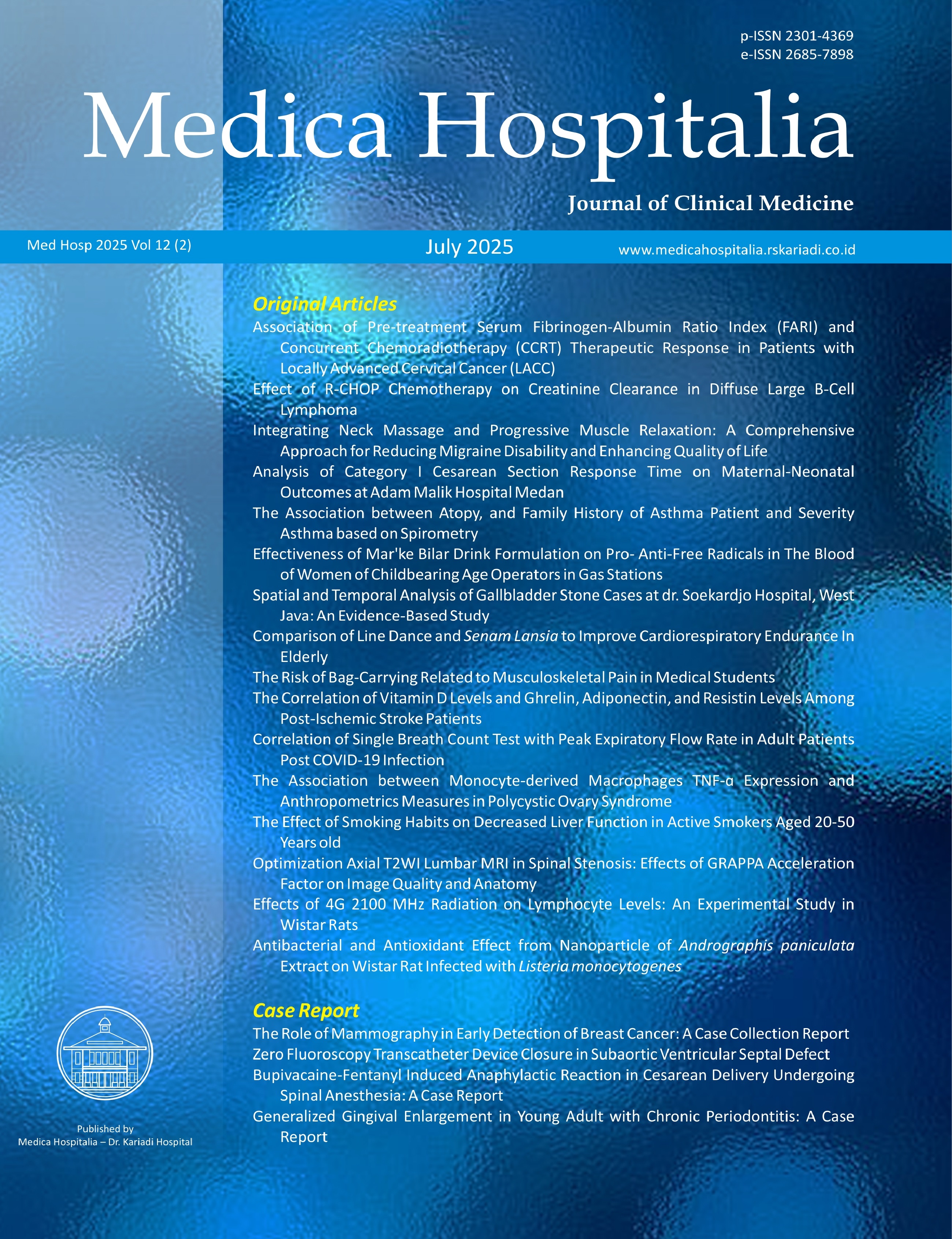The Effect of Smoking Habits on Decreased Liver Function in Active Smokers Aged 20-50 Years old
DOI:
https://doi.org/10.36408/mhjcm.v12i2.1229Keywords:
Active Smokers, Inflammatory event, Liver Enzymes, Productive Age, SmokingAbstract
BACKGROUND: A study was conducted to determine the effect of smoking habits on decreased liver function in active smokers aged 20-50 years. This study was motivated by Indonesia’s high smoking prevalence and its associated liver-related health issues. The liver is an organ that plays a role in the body's metabolism. Smoking triggers the formation of free radicals, causing a decrease in liver function and inflammation.
METHOD: In this study, mix method design was used with active smokers as the smoker group and the control group was respondents not active or passive smokers. Groups are categorized again based on age, ie 20-30, 31-40, and 41-50. The study population is the academic community of the Hermina Health Institute Jatinegara Campus and the community living on Kapitan III Road Tapos District, Depok City. Liver function is evaluated through enzymes SGPT, SGOT, ALP, and CRP as parameters for inflammation. To evaluate the influence of smoking habits and lifestyle factors on liver function risk, an analysis of variance (ANOVA) followed by post-hoc testing and linear regression analysis were performed.
RESULT: Laboratory results showed that mean levels of ALT, AST, ALP, and CRP were higher in the smoker group compared to controls across all age categories, although most values remained within normal limits. ANOVA revealed statistically significant differences in all biomarkers (p<0.05), and post-hoc tests identified specific age-related group differences. Smokers’ habit data indicated that most smokers began smoking between the ages of 15–20 and had smoked for over five years. Lifestyle analysis showed a higher prevalence of insufficient physical activity, reduced sleep duration, and higher BMI among smokers. CLDQ scores for both groups generally reported minimal emotional disturbance and no signs of advanced liver disease.
CONCLUSION: Smoking is associated with elevated liver enzymes (ALT, AST, ALP) and CRP levels, indicating subclinical hepatic and inflammatory alterations. These biochemical changes correlate with lifestyle risk factors and diminished quality of life. Early screening and lifestyle modification are recommended to prevent long-term hepatic damage among smokers.
Downloads
References
1. World Health Organization. Tobacco [Internet]. 2025 [cited 2025 May 10]. Available from: https://www.who.int/health-topics/tobacco#tab=tab_1
2. World Health Organization. Hari Tanpa Tembakau Sedunia [Internet]. 2020 May 30 [cited 2025 May 13]. Available from: https://www.who.int/indonesia/news/detail/30-05-2020-pernyataan-hari-tanpa-tembakau-sedunia-2020
3. Ntarisa AV. Heavy metals concentration and human health risk assessment in tobacco cigarette products from Tanzania. Chin J Anal Chem. 2024;52(8):100428.
4. Münzel T, Hahad O, Kuntic M, Keaney JF, Deanfield JE, Daiber A. Effects of tobacco cigarettes, e-cigarettes, and waterpipe smoking on endothelial function and clinical outcomes. Eur Heart J. 2020;41(41):4057–70.
5. Zhang J, Hou L, Lei S, Li Y, Xu G. The causal relationship of cigarette smoking to metabolic disease risk and the possible mediating role of gut microbiota. Ecotoxicol Environ Saf. 2025;290:117522.
6. Premkumar M, Anand AC. Tobacco, cigarettes, and the liver: The smoking gun. J Clin Exp Hepatol. 2021;11(6):700–12.
7. Ramos-González EJ, Bitzer-Quintero OK, Ortiz G, Hernández-Cruz JJ, Ramírez-Jirano LJ. Relationship between inflammation and oxidative stress and its effect on multiple sclerosis. Neurologia. 2024;39(3):292–301.
8. Balabanova L, Bondarev G, Seitkalieva A, Son O, Tekutyeva L. Insights into alkaline phosphatase anti-inflammatory mechanisms. Biomedicines. 2024;12.
9. Rosyidah N, Widyastuti E, Rahman AA, Handayani NS, Belgis. Correlation between SGOT and SGPT levels with positive HBsAg levels. J Vocational Health Stud. 2024;8(1):1–6.
10. Huh Y, Cho YJ, Nam GE. Recent epidemiology and risk factors of nonalcoholic fatty liver disease. J Obes Metab Syndr. 2022;31:17–27.
11. Bu LF, Xiong CY, Zhong JY, Xiong Y, Li DM, Hong FF, et al. Non-alcoholic fatty liver disease and sleep disorders. World J Hepatol. 2024;16(3):304–15.
12. Kalas MA, Chavez L, Leon M, Taweesedt PT, Surani S. Abnormal liver enzymes: a review for clinicians. World J Hepatol. 2021;13(11):1688–98.
13. Youssef EM, Wu GY. Subnormal serum liver enzyme levels: a review of pathophysiology and clinical significance. J Clin Transl Hepatol. 2024;12:428–35.
14. Kuroda R, Nogawa K, Watanabe Y, Morimoto H, Sakata K, Suwazono Y. Association between high-sensitive C-reactive protein and the development of liver damage in Japanese male workers. Int J Environ Res Public Health. 2021;18(6):1–11.
15. Hackshaw A, Morris JK, Boniface S, Tang JL, Milenković D. Low cigarette consumption and risk of coronary heart disease and stroke: meta-analysis of 141 cohort studies. BMJ. 2018;360.
16. Jain D, Chaudhary P, Varshney N, Bin Razzak KS, Verma D, Khan Zahra TR, et al. Tobacco smoking and liver cancer risk: potential avenues for carcinogenesis. J Oncol. 2021;2021.
17. Nivukoski U, Niemelä M, Bloigu A, Bloigu R, Aalto M, Laatikainen T, et al. Impacts of unfavourable lifestyle factors on biomarkers of liver function, inflammation and lipid status. PLoS One. 2019;14(6).
18. Roerecke M, Vafaei A, Hasan OSM, Chrystoja BR, Cruz M, Lee R, et al. Alcohol consumption and risk of liver cirrhosis: a systematic review and meta-analysis. Am J Gastroenterol. 2019;114(10):1574–86.
19. Hejazi K, Hackett D. Effect of exercise on liver function and insulin resistance markers in patients with non-alcoholic fatty liver disease: a systematic review and meta-analysis of randomized controlled trials. J Clin Med. 2023;12.
20. Um YJ, Chang Y, Jung HS, Cho IY, Shin JH, Shin H, et al. Sleep duration, sleep quality, and the development of nonalcoholic fatty liver disease: a cohort study. Clin Transl Gastroenterol. 2021;12(10):e00417.
21. Huang Z, Liu H, Zhuo W, Chen Y, Huang Y, Chen X, et al. U-shaped associations between body mass index and serum liver enzyme levels. Sci Rep. 2025;15(1).
22. Fathima FP, Kalyanikutty K. Liver function parameters in asymptomatic smokers: a cross-sectional study. Natl J Physiol Pharm Pharmacol. 2024;14(9).
23. Afriayani I, Anisa N, Bahar M. Pengaruh perokok sedang dan pasif terhadap kadar SGOT dan SGPT. Anakes J Ilm Analis Kesehatan. 2023;9(1).
24. Latafodes WK, Hidayah KNA, Riky. Gambaran kadar SGPT pada perokok aktif di usia 17–25 tahun dengan lama merokok < 10 tahun. J Borneo Cendekia. 2020;4(2).
25. Premkumar M, Anand AC. Tobacco, cigarettes, and the liver: the smoking gun. J Clin Exp Hepatol. 2021;11(6):700–12.
26. Umi Partan R, Reagan M, Hermansyah H, Darma S, Muthia P, Mediarty M, et al. Faktor risiko dan gejala osteoporosis pada komunitas dewasa di Desa Ibul Besar Pemulutan Ogan Ilir Sumatera Selatan. J Pengabdian Masyarakat: Humanity and Medicine. 2021;2(3):144–55.
27. Harahap S, et al. Hubungan faktor risiko dengan angka kejadian penyakit ginjal kronik di RS. Haji Medan pada tahun 2020. Jurnal Kesehatan. 2020;4.
28. Sproston NR, Ashworth JJ. Role of C-reactive protein at sites of inflammation and infection. Front Immunol. 2018;9.
29. Rutledge SM, Asgharpour A. Smoking and liver disease. Gastroenterol Hepatol. 2020;16.
30. Abdulkader RT, Kadhim SA. The effect of smoking on liver enzymes and its functions. J Pharm Negat Results. 2022;13(5).
31. Marti-Aguado D, Clemente-Sanchez A, Bataller R. Cigarette smoking and liver diseases. J Hepatol. 2022; 77:191–205.
32. Kalas MA, Chavez L, Leon M, Taweesedt PT, Surani S. Abnormal liver enzymes: a review for clinicians. World J Hepatol. 2021;13(11):1688–98.
33. Landry A, Docherty P, Ouellette S, Louis F, Cartier J. Causes and outcomes of markedly elevated C-reactive protein levels. Can Fam Physician. 2017;63.
Additional Files
Published
How to Cite
Issue
Section
Citation Check
License
Copyright (c) 2025 Mike Permata Sari, Afifa Radhina, Privia Muliamarshanti (Author)

This work is licensed under a Creative Commons Attribution-ShareAlike 4.0 International License.
Copyrights Notice
Copyrights:
Researchers publishing manuscrips at Medica Hospitalis: Journal of Clinical Medicine agree with regulations as follow:
Copyrights of each article belong to researchers, and it is likewise the patent rights
Researchers admit that Medica Hospitalia: Journal of Clinical Medicine has the right of first publication
Researchers may submit manuscripts separately, manage non exclusive distribution of published manuscripts into other versions (such as: being sent to researchers’ institutional repository, publication in the books, etc), admitting that manuscripts have been firstly published at Medica Hospitalia: Journal of Clinical Medicine
License:
Medica Hospitalia: Journal of Clinical Medicine is disseminated based on provisions of Creative Common Attribution-Share Alike 4.0 Internasional It allows individuals to duplicate and disseminate manuscripts in any formats, to alter, compose and make derivatives of manuscripts for any purpose. You are not allowed to use manuscripts for commercial purposes. You should properly acknowledge, reference links, and state that alterations have been made. You can do so in proper ways, but it does not hint that the licensors support you or your usage.
























